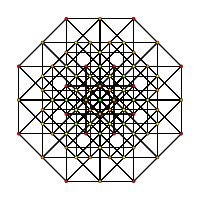| This article includes a list of references, related reading, or external links, but its sources remain unclear because it lacks inline citations. Please help improve this article by introducing more precise citations. (September 2022) (Learn how and when to remove this message) |
| 10-cube Dekeract | |
|---|---|
 Orthogonal projection inside Petrie polygon Orange vertices are doubled, and central yellow one has four | |
| Type | Regular 10-polytope e |
| Family | hypercube |
| Schläfli symbol | {4,3} |
| Coxeter-Dynkin diagram | |
| 9-faces | 20 {4,3} |
| 8-faces | 180 {4,3} |
| 7-faces | 960 {4,3} |
| 6-faces | 3360 {4,3} |
| 5-faces | 8064 {4,3} |
| 4-faces | 13440 {4,3,3} |
| Cells | 15360 {4,3} |
| Faces | 11520 squares |
| Edges | 5120 segments |
| Vertices | 1024 points |
| Vertex figure | 9-simplex |
| Petrie polygon | icosagon |
| Coxeter group | C10, |
| Dual | 10-orthoplex |
| Properties | convex, Hanner polytope |
In geometry, a 10-cube is a ten-dimensional hypercube. It has 1024 vertices, 5120 edges, 11520 square faces, 15360 cubic cells, 13440 tesseract 4-faces, 8064 5-cube 5-faces, 3360 6-cube 6-faces, 960 7-cube 7-faces, 180 8-cube 8-faces, and 20 9-cube 9-faces.
It can be named by its Schläfli symbol {4,3}, being composed of 3 9-cubes around each 8-face. It is sometimes called a dekeract, a portmanteau of tesseract (the 4-cube) and deka- for ten (dimensions) in Greek, It can also be called an icosaronnon or icosa-10-tope as a 10 dimensional polytope, constructed from 20 regular facets.
It is a part of an infinite family of polytopes, called hypercubes. The dual of a dekeract can be called a 10-orthoplex or decacross, and is a part of the infinite family of cross-polytopes.
Cartesian coordinates
Cartesian coordinates for the vertices of a dekeract centered at the origin and edge length 2 are
- (±1,±1,±1,±1,±1,±1,±1,±1,±1,±1)
while the interior of the same consists of all points (x0, x1, x2, x3, x4, x5, x6, x7, x8, x9) with −1 < xi < 1.
Other images
 This 10-cube graph is an orthogonal projection. This orientation shows columns of vertices positioned a vertex-edge-vertex distance from one vertex on the left to one vertex on the right, and edges attaching adjacent columns of vertices. The number of vertices in each column represents rows in Pascal's triangle, being 1:10:45:120:210:252:210:120:45:10:1. |
| B10 | B9 | B8 |
|---|---|---|

|

|

|
| B7 | B6 | B5 |

|

|

|
| B4 | B3 | B2 |

|

|

|
| A9 | A5 | |

|

| |
| A7 | A3 | |

|

| |
Derived polytopes
Applying an alternation operation, deleting alternating vertices of the dekeract, creates another uniform polytope, called a 10-demicube, (part of an infinite family called demihypercubes), which has 20 demienneractic and 512 enneazettonic facets.
References
- H.S.M. Coxeter:
- Coxeter, Regular Polytopes, (3rd edition, 1973), Dover edition, ISBN 0-486-61480-8, p.296, Table I (iii): Regular Polytopes, three regular polytopes in n-dimensions (n≥5)
- H.S.M. Coxeter, Regular Polytopes, 3rd Edition, Dover New York, 1973, p. 296, Table I (iii): Regular Polytopes, three regular polytopes in n-dimensions (n≥5)
- Kaleidoscopes: Selected Writings of H.S.M. Coxeter, edited by F. Arthur Sherk, Peter McMullen, Anthony C. Thompson, Asia Ivic Weiss, Wiley-Interscience Publication, 1995, ISBN 978-0-471-01003-6
- (Paper 22) H.S.M. Coxeter, Regular and Semi Regular Polytopes I,
- (Paper 23) H.S.M. Coxeter, Regular and Semi-Regular Polytopes II,
- (Paper 24) H.S.M. Coxeter, Regular and Semi-Regular Polytopes III,
- Norman Johnson Uniform Polytopes, Manuscript (1991)
- N.W. Johnson: The Theory of Uniform Polytopes and Honeycombs, Ph.D. (1966)
- Klitzing, Richard. "10D uniform polytopes (polyxenna) o3o3o3o3o3o3o3o3o4x - deker".
External links
- Weisstein, Eric W. "Hypercube". MathWorld.
- Olshevsky, George. "Measure polytope". Glossary for Hyperspace. Archived from the original on 4 February 2007.
- Multi-dimensional Glossary: hypercube Garrett Jones
- OEIS sequence A135289 (Hypercubes:10-cube)
| Fundamental convex regular and uniform polytopes in dimensions 2–10 | ||||||||||||
|---|---|---|---|---|---|---|---|---|---|---|---|---|
| Family | An | Bn | I2(p) / Dn | E6 / E7 / E8 / F4 / G2 | Hn | |||||||
| Regular polygon | Triangle | Square | p-gon | Hexagon | Pentagon | |||||||
| Uniform polyhedron | Tetrahedron | Octahedron • Cube | Demicube | Dodecahedron • Icosahedron | ||||||||
| Uniform polychoron | Pentachoron | 16-cell • Tesseract | Demitesseract | 24-cell | 120-cell • 600-cell | |||||||
| Uniform 5-polytope | 5-simplex | 5-orthoplex • 5-cube | 5-demicube | |||||||||
| Uniform 6-polytope | 6-simplex | 6-orthoplex • 6-cube | 6-demicube | 122 • 221 | ||||||||
| Uniform 7-polytope | 7-simplex | 7-orthoplex • 7-cube | 7-demicube | 132 • 231 • 321 | ||||||||
| Uniform 8-polytope | 8-simplex | 8-orthoplex • 8-cube | 8-demicube | 142 • 241 • 421 | ||||||||
| Uniform 9-polytope | 9-simplex | 9-orthoplex • 9-cube | 9-demicube | |||||||||
| Uniform 10-polytope | 10-simplex | 10-orthoplex • 10-cube | 10-demicube | |||||||||
| Uniform n-polytope | n-simplex | n-orthoplex • n-cube | n-demicube | 1k2 • 2k1 • k21 | n-pentagonal polytope | |||||||
| Topics: Polytope families • Regular polytope • List of regular polytopes and compounds | ||||||||||||